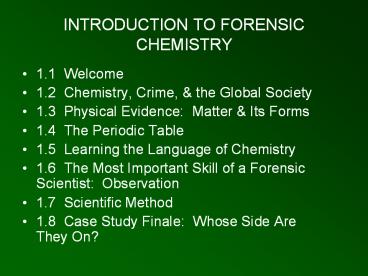INTRODUCTION TO FORENSIC CHEMISTRY - PowerPoint PPT Presentation
Title:
INTRODUCTION TO FORENSIC CHEMISTRY
Description:
INTRODUCTION TO FORENSIC CHEMISTRY 1.1 Welcome 1.2 Chemistry, Crime, & the Global Society 1.3 Physical Evidence: Matter & Its Forms 1.4 The Periodic Table – PowerPoint PPT presentation
Number of Views:6843
Avg rating:3.0/5.0
Title: INTRODUCTION TO FORENSIC CHEMISTRY
1
INTRODUCTION TO FORENSIC CHEMISTRY
- 1.1 Welcome
- 1.2 Chemistry, Crime, the Global Society
- 1.3 Physical Evidence Matter Its Forms
- 1.4 The Periodic Table
- 1.5 Learning the Language of Chemistry
- 1.6 The Most Important Skill of a Forensic
Scientist Observation - 1.7 Scientific Method
- 1.8 Case Study Finale Whose Side Are They
On?
2
INTRODUCTION TO FORENSIC CHEMISTRY
- Forensics means of the forum for public
debates and trials can be introduced into legal
procedings - Forensic Science requires knowledge of biology,
physics, geology, psychology, and chemistry, in
particular, and more. - Physical Evidence Matter Its Forms
- Matter exists as solids, liquids, or gases
- Liquids resist being compressed
- Gases are compressible
3
The universe is composed of matter and energy.
Matter is composed of mixtures and pure
substances. In matter There are two kinds of
pure substances and two kinds of mixtures.
4
1.3 PHYSICAL EVIDENCE MATTER AND ITS FORMS
- Matter is composed of mixtures and pure
substances. - Mixtures involve a physical blending of two or
more pure substances. - mixtures can be separated into their components
by physical means such as evaporation or
filtering - Homogeneous mixtures have uniform properties and
composition, for example, solutions (KoolAid). - Heterogeneous - variable composition, and often
show visible differences (Chocolate chip
cookies).
5
1.3 PHYSICAL EVIDENCE MATTER AND ITS FORMS
- Pure substances have uniform composition
(elements and compounds) - their components cant be separated by physical
means such as distillation. - Pure substances are composed of
- Elements. These contain only one type of atom.
Fe, Na, As, etc. - Compounds. These contain two or more types of
atoms. H2O, NaCl, KNO3, etc. - Compounds are of two types
- Molecular (covalent bonding), such as water,
alcohol, sugar, or CO2. - Ionic, such as salt, NaCl, or baking soda, NaHCO3.
6
A lead (Pb) bullet, a homogeneous mixture,
contains traces of impurities such as bismuth,
Bi, and antimony, Sb.Add in the dirt here, and
the whole sample becomes a heterogeneous mixture.
Differences are usually visible.
7
Can you sort the elements, compounds and mixtures?
- Identify each of these as a pure substance or a
mixture - then as either an element or a compound or as a
homogeneous or heterogeneous mixture.
Pure a, b, d Element b Compound a, d Mixture
c, e Heterogeneous c Homogeneous e Solutions
are homogeneous. H2, Fe, salt water, wet sand
(SiO2), pure baking soda (NaHCO3), gasohol,
ice-water (s l).
8
Introduction to the Periodic Table
- Symbols for the chemical elements are usually the
first letter or the first and second or first and
third letters. - Examples include H for hydrogen, C for carbon, Ca
for calcium, Zn for zinc, He for helium, and Mg
for magnesium. - Some elements were named by alchemists using
Latin - (These elements were known from antiquity.)
- Na for sodium, K for potassium, Au for gold, and
Ag for silver, Sb for antimony. - Hg for mercury, Fe for iron, Pb for lead, Cu for
copper, Sn for tin, etc. - Copper, silver, and gold still occur free in
nature. - You are responsible for knowing the symbol and
name for elements 1-95.
9
Introduction to the Periodic Table
- The table can be divided into metals, nonmetals,
and metalloids. - The metals predominate. They conduct heat and
electricity well. Mercury is the only liquid at
room temperature. - The nonmetals are poor conductors, except for
graphite, C. - Metalloids include boron, silicon, germanium,
arsenic, antimony, tellurium, polonium, and
astatine. They conduct electricity at high
temperatures.
10
(No Transcript)
11
THE MOST IMPORTANT SKILL OF A FORENSIC SCIENTIST
Observation and the Scientific Method
- Observation is the most important skill
- It is the first step in the scientific method.
- It requires good judgment and experience to
select the key evidence at a crime scene.
Critical thinking is essential. - It means being logical, rational, impartial, and
analytical.
12
- 2. How are gases characterized?
- A) By small distances between particles that are
moving at low speeds - B) By small distances between particles that are
moving at high speeds - C) By large distances between particles that are
moving at low speeds - D) By large distances between particles that are
moving at high speeds - 4. A molecule is defined as an atom.
- A)True
- B) False
13
- 6. Sugar in tea is an example of what?
- A) A complete mixture
- B) An incomplete mixture
- C) A heterogeneous mixture
- D) A homogeneous mixture

